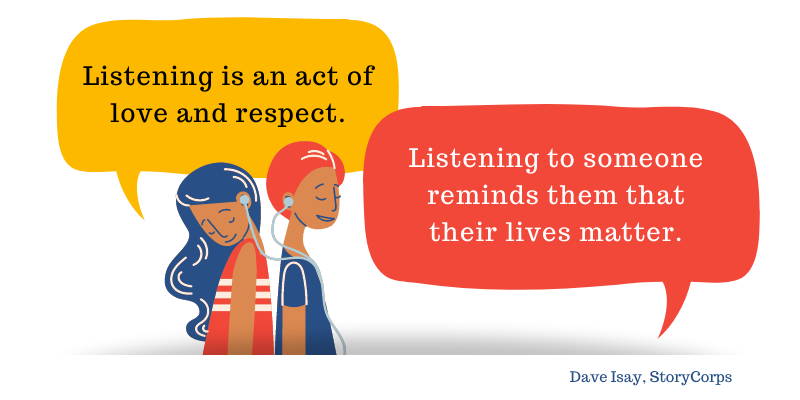This post was originally published as an assignment for INFO 287 Seminar in Information Science: The Hyperlinked Library at the School of Information at San José State University.
As a lifelong NPR listener, I can think of countless driveway moments where I sat alone or with my family in silence just listening. Gripped by an interview so compelling I couldn’t bring myself to disconnect it. The power of stories is indeed timeless, it links us to each other and human history. These are the stories you didn’t think you would listen to, but then can’t get out of the car, they stop you dead in your tracks. I think what I like most about these moments is their randomness.
Projects like the Human Library give people the chance to interview and listen to a living person (book). These opportunities offer incredible insight into people’s lives and experiences. But, like checking out a book from the library, you make a selection based on certain criteria. Thus, you may never learn about things entirely unknown to you.
I think podcasts serve as a form of a non-interactive human library. Take a glance at the top 50 podcasts for 2020, how many of these podcasts are some form of storytelling? Are podcasts so popular because they are essentially providing us opportunities to listen to people’s stories?
TED Talks offer more opportunities for listening. These curated listening experiences draw the audience in with dynamic oral histories. In this TedTalk, Shaun Yu, a classical music broadcaster, tells of his own driveway moment when he made a connection to what would become his passion.
Yet, we still curate a narrative by selecting or controlling the content we listen to. What happens when we are handed a story we didn’t expect to hear? This thought occurred to me while listening to the Power of Stories presentation. Kylie Carlson talks about the library’s programming that supports neuro-diverse kids. I was not expecting to hear about this underserved population. I don’t think I would have selected this choice. Nor would I have checked this book out at the Human Library. But my worldview is expanded by having her story land in my ear by listening to this lecture. Now that I possess knowledge of the needs of these kids, I will be more sensitive to this population when creating programming.
How can we create random listening opportunities?
Listening can come in the smallest bits. For example, the Twitter bot censusAmericans mines the data from the U.S. Census Bureau and sends it out as tweets, randomly generating small biographical sketches of Americans (Zhang).
These brief statements can be thought-provoking while scrolling through your Twitter feed. Offering opportunities to think about who this person might be.
Linked Data can provide a path to connectedness and randomness. Harnessing the power of this technology allows us to link the world’s oral histories in ways that will allow us to listen and learn from people from around the world and across time. A significant amount of the existing oral histories are trapped in archives. The crowd-sourced nature of Wikimedia projects makes for an excellent opportunity to unleash these archived histories with the power of metadata. The Wikimedia Foundation also seeks to find a way of making oral histories more accessible by providing an opportunity for people to record and contribute oral histories to Wikipedia without the use of a computer.
This idea sounds a lot like the StoryCorps app which allows interviewers to collect voices from their communities with their smartphones. The app provides all the tools to record, add metadata, and upload the content to the Library of Congress. Libraries can look to StoryCorps DIY to help build their own oral history collections. This resource is a collection of self-paced courses and multimedia tools to assist libraries and other community-based organizations with developing a collection of storytelling interviews within their intuitions.
What if oral histories were linked through data visualization? Projects like Linked Jazz connects oral histories, articles, and archives about Jazz musicians via a data visualization tool that allows browsers to learn how artists are connected, or simply just get lost in their degrees of separation.
If oral histories are loaded into Wikimedia Commons and linked with WikiData, they could then be accessed by asking our virtual assistants to tell us about someone. “Hey Siri, I’d like to check out a human library story about friendship” OR “Alexa, I would like to learn what it was like to be a student during the global pandemic of 2020”.
Michael Stephens describes narrative inquiry as a “compassionate way of reaching out, listening, and learning”. Through an interview, a careful listener will gain valuable insight into their community’s learning preferences, world views, and needs. Often listening can make us want to help. But, when we try to help, we are missing the point. People want to be heard. That is the most help we can provide. It broadens our perspective. But, listening is just the beginning, we must learn from the stories, and strengthen our connectedness to humanity by doing so.
